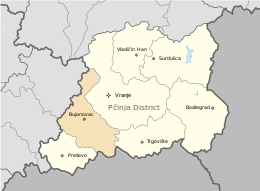Bujanovac
Bujanovac (Serbian Cyrillic: Бујановац, pronounced [bǔjanɔvats]; Albanian: Bujanoc) is a town and municipality located in the Pčinja District of southern Serbia.
Kale-Krševica, located south of Ristovac, is an archaeological site of a 5th-century BC Ancient city of Macedon, thought to be Damastion.
The Thracian Triballi and Paeonian Agrianes dwelled in the region, with the Scordisci settling here after the Gallic invasion of the Balkans in 279 BC.
After the establishment of the Kingdom of Serbs, Croats and Slovenians, in 1918, Bujanovac became part of Vranje Oblast, which was formed in 1921 after the Vidovdan Constitution.
In 1992, the Albanians in the area organized a referendum in which they voted that Bujanovac, Preševo and Medveđa should join the self-declared assembly of the Republic of Kosova.
Following the breakup of Yugoslavia, and nearby Kosovo War which lasted until 1999, between 1999 and 2001, an ethnic Albanian paramilitary separatist organization, the UÇPMB, raised an armed insurgency in the Preševo Valley, in the region mostly inhabited by Albanians, with a goal to occupy these three municipalities from Serbia and join them to the self-proclaimed Republic of Kosova.
Unlike in the case of Kosovo, western countries condemned the attacks and described it as the "extremism" and use of "illegal terrorist actions" by the group.
On 7 March 2017, the President of Albania Bujar Nishani made a historical visit to the municipalities of Bujanovac and Preševo, in which Albanians form the ethnic majority.

